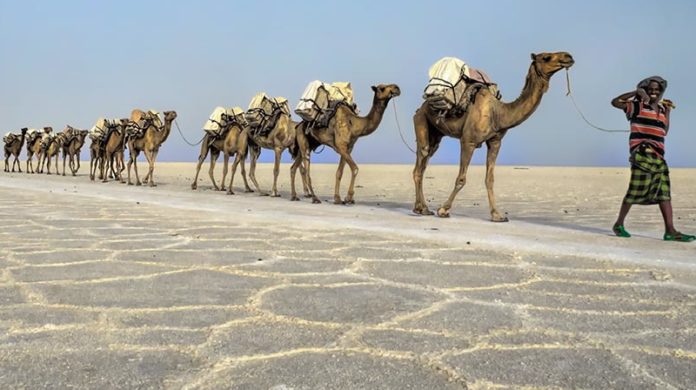
The Danakil Depression in Eritrea is as inhospitable a location as it’s possible to find. It is hot, temperatures soar to 50 degrees Celsius, unpeopled and unserved by infrastructure, and mind-bendingly dry: the region averages a mere 100 to 200 millimetres in rainfall annually.
But it is also the focus for millions of dollars in new investment. That’s because the eastern section of Danakil, close to the border with Ethiopia, is home to the Colluli Potash Project – a crop fertiliser mineral that is winning the attention of investors.
Colluli is a joint venture between Sydney- and London-listed Danakali Ltd and the Eritrean government. Situated on the eastern section of the Danakil Depression, close to the Ethiopian border, Colluli contains 200 years of sulphate of potash, or SOP.
Normally, the only visitors to this region of Eritrea are the Afar, a people who mine the vast plains of sulphur and hot springs for surface salt, which they prise from the ground and cut into blocks ready for transport, normally by camel.
Somewhere in this vastness you’ll also find signage, erected by Danakali. It is planning to begin first major production of potash in 2022. About $250m of some $320m in total finance required has already been tied up from the African Finance Corporation (AFC) and Afreximbank. There’s also an offtake agreement for the first module of production with EuroChem Group, an established German fertiliser company.
“The beauty of our project is that we’re producing from solid salts and that means you don’t have to go through evaporation ponds, which will take a lot longer to get from the ore to the finished products,” says Niels Wage, CEO of Danakali, in an interview.
“So we can get into a finished product relatively quickly, a couple of weeks, before you actually have to get the ore processing,” he says. From ore to product is a straightforward process of crushing, mixing, drying before popping it onto a ship. Eritrea also borders the Red Sea. Anfile port, the proposed loading area for Colluli potash, is a mere 87 kilometres away.
Provided the asset is good, financing projects of this ilk ticks a lot of boxes for lenders, especially development finance institutions such as the AFC, which sees in Colluli an opportunity to accelerate Eritrea’s economic recovery from a 20-year war with Ethiopia, which ended in 2018.
FEEDING THE WORLD
According to a World Bank report, an estimated 700 million people in developing economies don’t have sufficient access to food to ensure healthy living. The ‘why’ behind this, however, is slightly more nuanced. It’s not a lack of food, says the bank, but a deficit in purchasing power in developing economy households. Improving the lot of local farmers is, therefore, key.
“Most African farmers don’t have access to fertiliser at all,” says Brad Simpson, CEO of Kore, a potash development company also listed in London and Johannesburg. Sampson thinks that, ultimately, Africa has the ability to feed other parts of the world, as well as itself.
We’ve been positively surprised by lenders. We are quietly confident arranging debt won’t be a problem.
Kore operates in the Republic of Congo, an almost complete east to west transverse across the African continent. Kore recently published the results of a pre-feasibility study for its Dougou Extension (DX) project, scoped at pre-production costs of $286m. “We’ve been positively surprised by lenders. We are quietly confident arranging debt won’t be a problem,” Sampson says.
One of the consequences of the COVID-19 pandemic has been to cast a light on social injustice and, to some extent, to co-dependence of the human species, notwithstanding the polarising effect of some politics currently abroad.
Social investing, however, was already part of the zeitgeist before COVID-19. In June, Finland’s Finnfund Global Impact Fund I was launched. Focusing on sustainable energy and agribusiness exclusively in Africa, the fund is one of the latest of a rising tide in so-called impact investing.
According to an annual poll of 1,700 investors conducted by Global Impact Investing Network (GIIN), assets under management in impact funds increased 50% to $715bn in the past year.
“The opportunity of looking at how you can contribute to the social, ESG (environment, sustainability, governance) aspect of investment is definitely going to be an increasing factor,” says Wage. In addition, the way in which COVID-19 has affected politics seems to work against developing economies in terms of sourcing food.
The World Bank, commenting in its semi-annual commodities report in April, highlighted a short-term concern that might develop into a trend. It cited “recent announcements of trade restrictions” by exporters such as Russia as well as ‘excess’ buying by importers having raised concerns about food security and the possibility of hoarding.
“Low-income countries are more vulnerable to food insecurity, as food accounts for a large proportion of their consumption than in EMDEs (emerging market and developing economies), particularly among the poorest households,” it said. It identified sub-Saharan Africa, where about a fifth of the population suffers from malnutrition.
Wage says Colluli’s SOP has specific environmental advantages. It allows for better conservation of water and certain crop benefits that he thinks will continue to gain currency, especially if industries are government-supported where environmentally-friendly measures will become mandatory. SOP also contains low chloride, which assists with crops that don’t react well to the substance.
In the other corner of the product contest, so to speak, is muriate of potash (MOP) which is Kore’s product. A function of different geological deposition, MOP yields the highest potassium, says Sampson. Both Kore and Danakali claim low cost of production, niche demand, and ample resources.
The fertiliser mineral industry is a complex one. Some crops prefer low chloride, others benefit from other chemical nuances; there’s even a market for the zinc and manganese that can be retrieved from recycling alkaline batteries, according to Lithium Australia, which has also targeted the fertiliser sector as supplementary to its own lithium mining.
But with so much of the stuff apparently about – BHP’s mammoth $17bn Jansen potash project in Canada’s Saskatchewan contains an estimated 2.3bn dry tons of potassium oxide – it begs the question as to whether the market will be flooded relatively quickly, and for a long time.
We actually need to reduce the amount of land dedicated to agriculture by 20% to 30%. This is the long view, and we need to improve the productivity of land that we have under agriculture by 30% to 50%. We think these types of products actually play into that imperative.
Says Sampson: “Even a BHP scale project will fall into demand growth and, anyway, it’s not in BHP’s interests to kill the market”. The MOP market is worth about 67m tons a year against which Jansen will produce 8m tons annually. Sampson’s optimism though is linked to the fact that fertiliser mineral growth is tied to long-term population growth of two to three per cent a year. “Regardless of how this plays out, people need to be fed,” says Sampson.
Anglo American surprised the market last year by adding its name into the mineral fertiliser industry following its £405m takeover of Sirius Minerals, a UK firm that was developing the Woodside project in northern England. Woodside is interesting because it contains up to 100 years of polyhalite, another play on the fertiliser mineral industry.
Polyhalite has no market as yet, but Anglo CEO, Mark Cutifani, says his group has taken a calculated bet on its ability to get the marketing from mine to customer spot on. The key, he thinks, is that polyhalite has a diversity of mineral properties that allow for it to be blended with SOP and MOP. As such, Woodside is a play on the growing sophistication of end-user consumption. The resource is also amenable to the bulk mining Anglo knows well.
Says Cutifani: “We actually need to reduce the amount of land dedicated to agriculture by 20% to 30%. This is the long view, and we need to improve the productivity of land that we have under agriculture by 30% to 50%. We think these types of products actually play into that imperative”.








